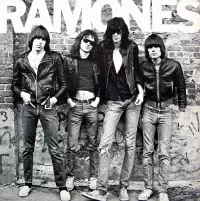Hey ho, let's go! This is it, patient zero for the contagion that is punk rock. This is the album that, by a pretty general consensus, is considered the first punk album ever made (cue the comments section) meaning that this album started not just one genre, but laid down the blueprint that several different genres built off of, from new wave to post-punk to alternative to indie rock. Essentially about 90% of the rock music that has been produced over the past 40 years owes its existence, first and foremost, to this album. But do classics always hold up over time? Or do we just appreciate them for what they did in their own time?
Well, both. There are two things about this album that don't hold up 40 years later. The first is the album’s tempo, which always feels like it's about a half a beat behind what we’ve now come to expect from punk. The Ramones can hardly be faulted, though, for not living up to the future expectations of a genre they were literally in the midst of creating. Still, every cover version of The Ramones, as well as many of The Ramones’ own later live recordings of these same songs, remedied this problem by speeding up the tempo.
What's less forgivable is the song “Loudmouth†which, along with songs like The Misfits’ “Attitude†and The Descendents’ “Catalina,†show a dark streak of misogyny in early punk (cue the comments section, again). Not only does “Loudmouth†feed off of sexist double standards and expectations of women to be calm and docile, but Joey Ramone actually says “I'm gonna beat you up†when singing to his “baby.†Such blatant threats of domestic violence can't simply be dismissed because of the time period the song was written in. There's no excuse for “Loudmouth,†and it remains a very unfortunate blemish on such a historically important album.
Okay, now that we've gotten that out of the way, there's really nothing else to complain about with this truly revolutionary album. Johnny Ramone’s constant, rapid downstroke playing style, which was completely revolutionary at the time, served as the backbone for punk and all of its offshoot genres, as well as getting picked up by British heavy metal artists. But for all the freshness of this sound, the Ramones were still true to the mantra that the Clash would later introduce: “No Elvis, Beatles, or the Rolling Stones!†That is to say that punk saw itself as a reset button, bringing Rock ‘n’ Roll back to its earliest days of artists like Chuck Berry and Buddy Holly—the last good era of rock music, as far as most punks were concerned—and intentionally ignoring the greater excesses of rock that built up in the 1960’s and 1970’s. There cannot be any doubt that The Ramones were true to this ethos, as exemplified by the album’s cover of the 1962 early Rock ‘n’ Roll hit “Let’s Dance†by Chris Montez.
The album’s themes of alienation still resonate today. “Now I Wanna Sniff Some Glue†has always been one of my favorite songs from this album, despite the fact that I have never once been tempted to sniff glue. The song isn’t just about drug use, but about the drug use of bored youth desperately trying to find something to fill their lives with. A big part of what this album is rebelling against is boredom, which is something the group explicitly set out to do because of their boredom with modern rock music. The lyrics pull from cheap, pulp entertainment, giving us an absurd, B-movie lens to view 1976 New York youth culture through. “Chain Saw†gives us a bizarre love story, somehow set in the movie Texas Chainsaw Massacre, in which the singer pines over his love being taken somewhere she won’t get out of (presumably Leatherface’s basement), but switches back and forth between being concerned about her and merely being bored by the lack of her presence. “Judy is a Punk†(but the song says Jackie’s the punk, Judy’s the runt?) is another bizarre song with little context about two women running away, first to Berlin to join the Ice Capades (which are not German) and then to San Francisco to join “the SLA,†which given the time period and location, is most likely referring to the Symbionese Liberation Army, the left-wing American militia that was most notable for kidnapping Patty Hearst. The song then goes into an off-handed wondering of whether or not these two women are going to die. Does anybody know what this song is supposed to ultimately mean? Did Joey Ramone even know? I don’t think it even had a real meaning, but, like so much of this album, just wants to wake us up with its absurdism.
The Ramones went on to have a long and storied career, as we’re covering all this week, but for me, the first LP is always going to be the best (comments section explodes). It’s a genuine piece of post-modern, Warhol-esque silliness and absurdism that jolts you awake to try to find some way out of the slog of your boredom. It’s an album that says there has to be more to life than what we have, that we have a right to expect to be happy and joyful and really fucking weird people. This universal theme is a big part of why this album sparked a movement, a musical revolution, and an entire musical family tree of countless artists over 40 years taking what the Ramones built and doing something completely new with it again and again.
